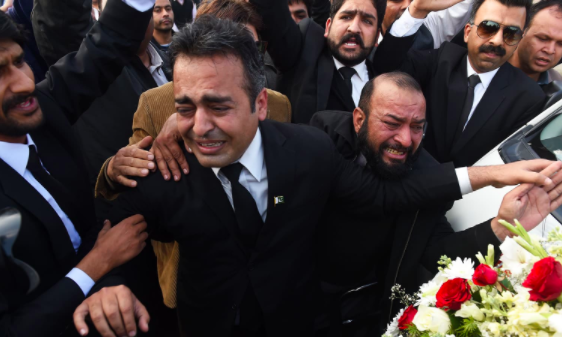Asma Jahangir's funeral bridges religious and ethnic divides
Originally by Marvi Sirmed on Daily Times

Asma Jahangir’s funeral was an emotionally draining yet an energising experience in unique ways. People of all ages, genders, ethnicities, religions, and social classes came to bid adieu to her. Only she could manage to amass such a wide spectrum of the society at such an occasion.
There were trans people, women, men, youngsters, older people, people descending from SUVs with their guards, people coming on motorbikes, as well as people pouring in on foot because public transport left them far from the venue owing to security arrangements. There were destitute women who had secured shelter because of Asma. There were activists who had spent lifetime in struggling for people’s rights, under Asma’s guidance and leadership. There were people whose lives she had changed by merely being there when they needed help. There were people who found meaning in their lives while being with her.
There were people from practically all walks of life and widest possible range of classes. Religious scholars who admired her work were also in attendance. One Mufti sahib came looking for me from the thick crowd, and told me what a big fan of Asma Jahangir he was. Another cleric, who insisted he was not a mullah but just a deeply religious man, told me he hadn’t met a person more courageous, honest and upright as Asma.
The funeral prayer was led by Haider Farooq Maudoodi, who opposes Islamists and is considered closer to Marxists. His views against political Islam, mullahism and exploitation of religion for political power games are well known, just as his famous revolt from his father Maulana Abul A’ala Maudoodi. Farooq had a long-standing relationship with Asma’s family and he supported the values Asma stood for.
The striking feature of this unique funeral ceremony was the predominant presence of women and the role they played throughout the event. At 11:45am when the body arrived at Asma’s home from the mortuary, women took it from the ambulance to the drawing room, which had been emptied already by removing all furniture. Women of the family and Asma’s comrades from Women’s Action Forum were all clad in identical black dresses with yellow scarves inscribed with women empowerment slogans.
After almost three hours, when the body had to be shifted to the ambulance again for the funeral procession, it was these women who carried her to the ambulance.
While the close family, her husband, children, and siblings sat in the ambulance, other women escorted the slow moving ambulance to the venue on foot.
Defying another regressive tradition, women shouldered her funeral bed – a practice conventionally considered a strictly male domain.
It’s not very frequent that so many women are seen in public spaces on such occasions. Their presence gave an egalitarian look to the funeral ceremony. Afterwards, men and women made rows and said the prayers together.
This was a rare and unforgettable sight. Men and women from all religions – Hindus, Sikhs, Christians, and Muslims of all sects, arranged in rows like beautiful pearls of different colours in one thread.
Women defied the established code. After the prayers, they raised slogans reiterating their vows to carry forward the legacy of Asma Jehangir.
The Government of Pakistan decided not to respond to people’s demands of flying the national flag at half-mast or of arranging a state funeral for her. Asma was much bigger than a state funeral anyway. Activists making these demands had only hoped that the state of Pakistan would honour itself by acquiescing.
It was hardly a surprise that some institutions and organs of the state maintained radio silence on the occasion. No public condolance, message of solidarity or eulogy or even a prayer for the departed came from those corridors. Not to mention, this hasn’t impacted Asma’s stature one bit.
Expressing solidarity with the mourners would have elevated state’s own perception among the public.
The sentiments of love and respect that people demonstrated for Asma Jehangir are unprecedented in recent history of this country.
Her detractors and haters, on the other hand, remain inconsequential and unknown. No one would even know when they die. But here is Asma Jahangir – who went like the majestic queen of hearts she has been. This probably is her revenge! But her ultimate revenge would be in continuation of her mission with all the energies of her supporters combined. The attainment of a progressive, democratic, secular and peace-loving Pakistan will be the ultimate revenge.
Sindhis, Siraiki, Pakhtuns, Baloch, Hazaras, Gilgitis, Baltis and others from far-flung areas came to bid farewell to their comrade. A Pakhtun contingent was most conspicuous for their number and for their vibrancy. They were the last people who were addressed by Asma in a public setting during their recent sit-in in Islamabad.
If one word can describe the funeral procession, it is pluralism. That’s what Asma Jehangir lived for as well. Her funeral looked like Pakistan. A truly federal Pakistan with all communities represented.
Even in her death, she did not conform to the established code. Resistance, thy name is Asma.


